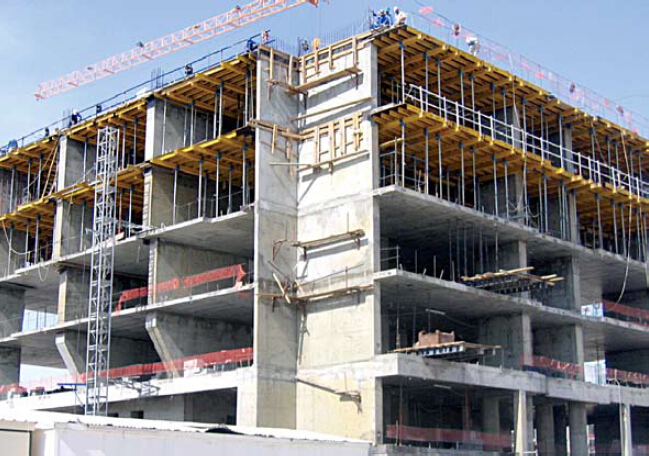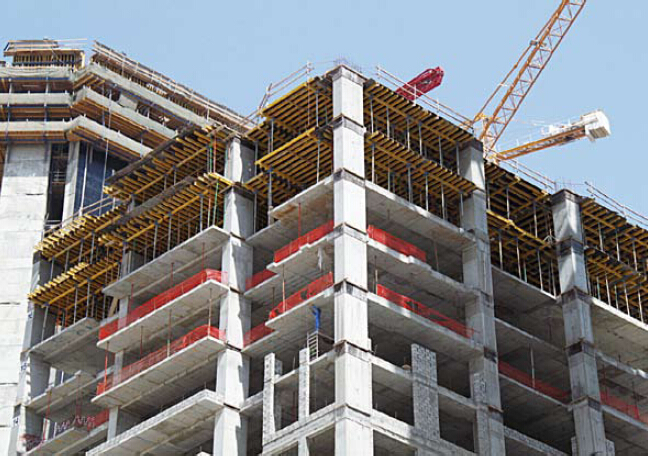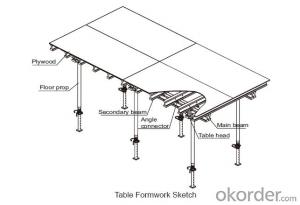Tabel formwork system for Formwork and Scaffolding Build
- Loading Port:
- Tianjin
- Payment Terms:
- TT or LC
- Min Order Qty:
- 50 m²
- Supply Capability:
- 1000 m²/month
OKorder Service Pledge
OKorder Financial Service
You Might Also Like
Product Specifications:
OKorder is offering high quality Building Scaffolding Table Formwork Systems at great prices with worldwide shipping. Table formwork is the most typical application, suitable for use with slabs or timber beam. Slab formwork is lightweight easy to erect and economical. Our supplier is a world-class manufacturer of scaffolding, and our products are utilized the world over, with OKorder annually supplying a full range of products to European, North American and Asian markets.
Product Applications:
Building Scaffolding Table Formwork Systems are for use in interior or exterior applications, and are designed to endure everyday use around a construction sites and remodeling projects.
Product Advantages:
OKorder's Building Scaffolding Table Formwork Systems help you get your project off the ground, with improved safety, economical construction and standardized parts.
Main Product Features:
· Improved safety with handrails
· Easy assembly
· Flexible structure, suitable for varied support systems
· Increases construction efficiency
· Formwork forklift and trolley compatible
· Flexible application with stand alone props
FAQ:
Q1: Why buy Materials & Equipment from OKorder.com?
A1: All products offered by OKorder.com are carefully selected from China's most reliable manufacturing enterprises. Through its ISO certifications, OKorder.com adheres to the highest standards and a commitment to supply chain safety and customer satisfaction.
Q2: How do we guarantee the quality of our products?
A2: We have established an advanced quality management system which conducts strict quality tests at every step, from raw materials to the final product. At the same time, we provide extensive follow-up service assurances as required.
Q3: What are the capacity requirements for all scaffolds?
A3: Each scaffold and scaffold component must support without failure its own weight and at least 4 times the maximum intended load applied or transmitted to it. Scaffolds and scaffold components must not be loaded in excess of their maximum intended loads or rated capacities, whichever is less. Load carrying timber members should be a minimum of 1,500 lb-f/in² construction grade lumber.
Q4: Should I use steel scaffolding or aluminum scaffold?
A4: If your job will run 6-8 weeks or more, steel scaffolding will actually be cheaper for you. Projects that run for a few hours to a few weeks are generally more practical and economical to do with aluminum scaffolding.
Q5: Is aluminum scaffold suitable for outdoor use?
A5: Aluminum scaffolding is designed to endure any weather conditions. It is tested to handle the cold winters of North America and Europe, and the extreme heats of Australia and Africa.
Q6: When should I order caster wheels versus leveling jacks?
A6: Order wheels for inside use. We do not recommend them outside unless on hard surface such as concrete or asphalt. Use level jacks outside or inside. Level jacks offer adjustability of the platform height of greater than 1500px.
Images:



- Q:Can steel formwork be used for both straight and sloping structures?
- Yes, steel formwork can be used for both straight and sloping structures. Steel formwork is a versatile and flexible construction material that can be customized to fit various shapes and configurations. It can be easily adjusted and secured to create straight walls and columns. Additionally, with the use of specialized accessories and components, steel formwork can also be adapted to create sloping structures such as ramps, inclined walls, and curved surfaces. This flexibility and adaptability make steel formwork a preferred choice for construction projects with varying design requirements.
- Q:How does steel formwork handle different concrete durability requirements?
- Steel formwork is a versatile and durable solution that can effectively handle different concrete durability requirements. The strength and rigidity of steel make it ideal for withstanding the pressures and stresses exerted by the concrete being poured. Steel formwork is highly adaptable and can be customized to meet specific durability requirements. This allows for the creation of formwork systems that are capable of withstanding harsh environmental conditions, such as extreme temperatures, moisture, and chemical exposure. Additionally, steel formwork can be designed to accommodate various load-bearing requirements, ensuring that the structure remains stable and secure during and after the concrete casting process. Moreover, steel formwork offers excellent dimensional stability, which is essential for achieving accurate and precise concrete finishes. This is particularly important when constructing structures that require a high level of aesthetic appeal or when intricate architectural designs are involved. Another advantage of steel formwork is its reusability. Unlike other types of formwork, steel can be used multiple times, minimizing waste and reducing overall construction costs. This makes it a cost-effective solution for projects with varying concrete durability requirements, as the formwork can be easily adjusted and reused for different applications. In summary, steel formwork is a reliable and adaptable solution that can effectively handle different concrete durability requirements. Its strength, customizability, dimensional stability, and reusability make it an ideal choice for a wide range of construction projects, ensuring that the concrete structures meet the desired durability standards.
- Q:Are there any disadvantages to using steel formwork?
- Yes, there are a few disadvantages to using steel formwork. Firstly, steel formwork is generally more expensive to purchase and maintain compared to other types of formwork materials. Additionally, steel formwork is heavier and more difficult to handle and transport, which can increase labor costs and project timelines. Furthermore, steel formwork requires skilled labor for assembly and dismantling, adding to the overall project costs. Lastly, steel formwork may not be suitable for all types of construction projects, especially those involving complex or irregular shapes.
- Q:What are the fire resistance properties of steel formwork?
- Steel formwork is renowned for its exceptional fire resistance. Being a non-combustible material, steel does not burn or contribute to the propagation of fire. Its high melting point confers remarkable resistance to heat and flames. In case of a fire, steel formwork remains intact, ensuring the safety of workers and preventing the fire from spreading to other areas. In addition, steel formwork does not release toxic fumes or smoke when exposed to high temperatures, unlike wood or plastic, which are commonly used in construction. This aspect is crucial as toxic fumes can be harmful and impede evacuation efforts during a fire emergency. Moreover, steel formwork exhibits low thermal conductivity, meaning it does not readily transfer heat. This feature helps confine the heat within the fire zone, curbing its spread to adjacent areas. It also diminishes the risk of structural damage caused by material expansion and contraction due to heat exposure. All in all, the fire-resistant properties of steel formwork render it a dependable choice for construction projects, particularly in locations where fire safety is of utmost importance. Its non-combustible nature, high melting point, absence of toxic fumes, and low thermal conductivity collectively contribute to establishing a secure and safeguarded environment in the face of potential fire hazards.
- Q:Is steel formwork suitable for all types of construction projects?
- Steel formwork is a versatile and widely used construction material that is suitable for a variety of construction projects. However, it may not be suitable for all types of construction projects. Steel formwork offers several advantages such as durability, reusability, and high load-bearing capacity. It can be used for both large-scale and small-scale projects, including residential, commercial, industrial, and infrastructure projects. Steel formwork is particularly well-suited for projects that require a high degree of precision and quality finish, such as high-rise buildings, bridges, and tunnels. However, there are certain factors to consider when determining the suitability of steel formwork for a specific construction project. One important factor is the project's budget. Steel formwork tends to have a higher initial cost compared to other types of formwork materials such as timber or aluminum. Therefore, it may not be suitable for projects with tight budget constraints. Another factor to consider is the project's timeline. Steel formwork requires skilled labor and time for assembly, disassembly, and transportation. This may result in longer construction periods, which may not be feasible for projects with strict deadlines. The complexity of the project is also an important factor to consider. Steel formwork is highly adaptable and can be custom-made for specific project requirements. However, if the project involves irregular or complex shapes, it may be more challenging and time-consuming to construct steel formwork compared to other types of formwork materials. Additionally, the environmental conditions of the construction site should be taken into account. Steel formwork is durable and can withstand harsh weather conditions. However, it may not be suitable for projects in coastal areas or locations with high humidity, as steel is susceptible to corrosion. In conclusion, while steel formwork is suitable for a wide range of construction projects, its suitability should be evaluated on a case-by-case basis. Considerations such as budget, timeline, complexity of the project, and environmental conditions should be taken into account to determine if steel formwork is the most suitable choice for a specific construction project.
- Q:How does steel formwork handle different concrete reinforcement types?
- Steel formwork is a versatile and durable option for handling different types of concrete reinforcement. It is commonly used in construction projects to create temporary molds or structures to hold concrete in place during the pouring and curing process. One of the advantages of steel formwork is its ability to handle different concrete reinforcement types. Whether it is traditional reinforcement such as steel bars or modern reinforcement techniques like fiber-reinforced polymers (FRP), steel formwork can accommodate them all. Steel formwork is designed to be strong and rigid, which allows it to support the weight and pressure exerted by different types of reinforcement materials. Whether it is the weight of steel bars or the tensile strength of FRP, steel formwork can withstand these forces without deforming or collapsing. Additionally, steel formwork is highly adaptable and can be easily adjusted or modified to accommodate different reinforcement types. It can be cut or welded to create openings or recesses for steel bars or other reinforcement materials to pass through. This flexibility ensures that steel formwork can be customized to suit the specific needs of each construction project. Furthermore, steel formwork offers a smooth and even surface finish, which is crucial for ensuring proper adhesion between the concrete and the reinforcement materials. This ensures that the reinforcement is securely embedded within the concrete structure, providing the necessary structural integrity and strength. In conclusion, steel formwork is a reliable and effective solution for handling different concrete reinforcement types. Its strength, adaptability, and ability to provide a smooth surface finish make it an ideal choice for construction projects that require diverse reinforcement materials.
- Q:What are the different types of tie systems used in steel formwork?
- There are several types of tie systems used in steel formwork, including through ties, external ties, and snap ties. Through ties are typically used for large wall formwork, where steel rods are inserted through the formwork and secured with nuts and plates on both sides. External ties are used for smaller wall panels, where steel rods are attached to the exterior of the formwork and anchored to the ground or surrounding structures. Snap ties are commonly used for column formwork, where metal or plastic cones are inserted into the formwork and secured with a metal snap tie. These tie systems provide stability and strength to the steel formwork during concrete pouring and curing.
- Q:Can steel formwork be used for precast concrete cladding panels?
- Yes, steel formwork can be used for precast concrete cladding panels. Steel provides durability and strength, making it an ideal material for creating formwork that can withstand the pressures exerted by the concrete during the casting process. Steel formwork also allows for precise shaping and detailing of the cladding panels, ensuring a high-quality finish.
- Q:Can steel formwork be used in areas with limited construction equipment access?
- Yes, steel formwork can be used in areas with limited construction equipment access. Steel formwork is a versatile and durable construction material that can be easily transported and assembled. It requires minimal equipment for installation and can be manually handled by a small team of workers. Therefore, it is well-suited for construction sites with limited equipment access, allowing for efficient and cost-effective construction in such areas.
- Q:How does steel formwork affect the overall thermal performance of the building?
- Steel formwork can have a significant impact on the overall thermal performance of a building. The thermal performance of a building refers to its ability to effectively regulate heat transfer between the interior and exterior environments. One key aspect of steel formwork that affects thermal performance is its conductivity. Steel is a highly conductive material, meaning it can easily transfer heat. This can result in higher heat transfer rates between the inside and outside of the building, which can lead to increased energy consumption for heating and cooling. Additionally, steel formwork can create thermal bridging. Thermal bridging occurs when there is a continuous path of high thermal conductivity, such as steel, that allows heat to bypass insulation. This can result in localized areas of heat loss or gain, reducing the overall effectiveness of insulation and compromising the thermal performance of the building. To mitigate these issues, various strategies can be employed when using steel formwork. One approach is to incorporate thermal breaks into the formwork system. Thermal breaks are insulating materials that are placed between the steel and the concrete, reducing the conductivity and minimizing thermal bridging. This helps to maintain a more consistent temperature throughout the building envelope and improves overall energy efficiency. Another strategy is to augment the insulation system by adding additional insulation layers to compensate for the heat transfer through the steel formwork. This can be done by applying insulation materials over the formwork or incorporating insulating layers within the concrete structure itself. Overall, while steel formwork can potentially have a negative impact on the thermal performance of a building, proper design considerations and the use of insulation and thermal break systems can help mitigate these effects and ensure a more energy-efficient and comfortable indoor environment.
1. Manufacturer Overview |
|
|---|---|
| Location | |
| Year Established | |
| Annual Output Value | |
| Main Markets | |
| Company Certifications | |
2. Manufacturer Certificates |
|
|---|---|
| a) Certification Name | |
| Range | |
| Reference | |
| Validity Period | |
3. Manufacturer Capability |
|
|---|---|
| a)Trade Capacity | |
| Nearest Port | |
| Export Percentage | |
| No.of Employees in Trade Department | |
| Language Spoken: | |
| b)Factory Information | |
| Factory Size: | |
| No. of Production Lines | |
| Contract Manufacturing | |
| Product Price Range | |
Send your message to us
Tabel formwork system for Formwork and Scaffolding Build
- Loading Port:
- Tianjin
- Payment Terms:
- TT or LC
- Min Order Qty:
- 50 m²
- Supply Capability:
- 1000 m²/month
OKorder Service Pledge
OKorder Financial Service
Similar products
New products
Hot products

























